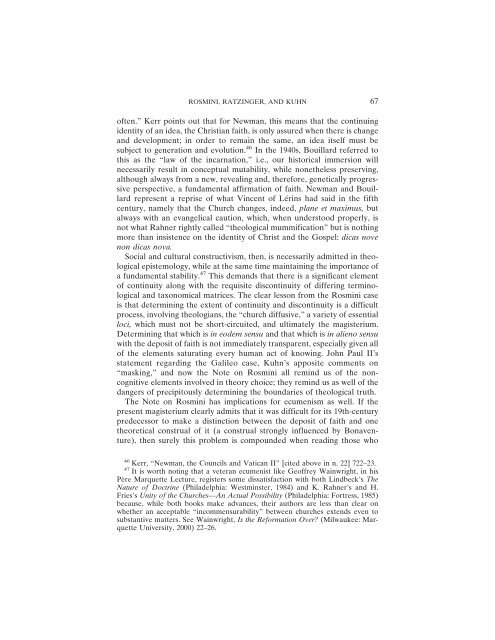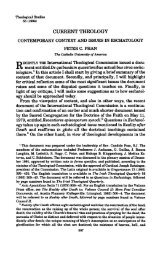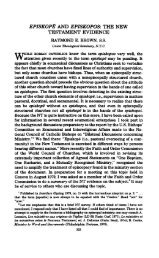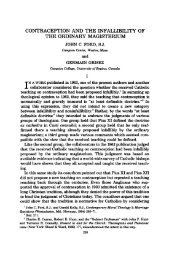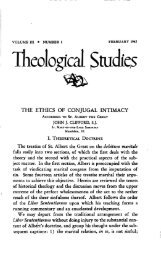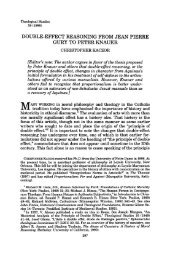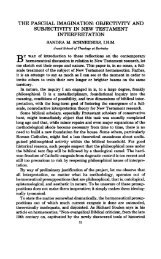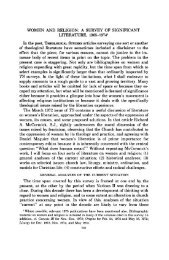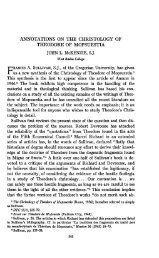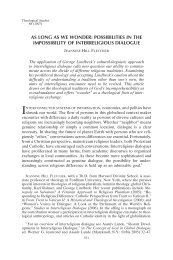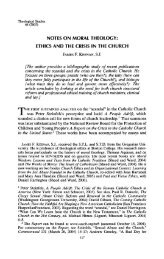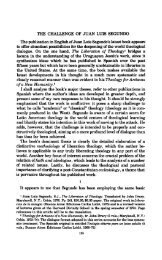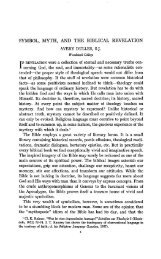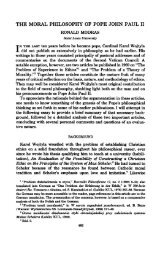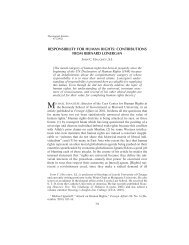rosmini, ratzinger, and kuhn - Theological Studies
rosmini, ratzinger, and kuhn - Theological Studies
rosmini, ratzinger, and kuhn - Theological Studies
You also want an ePaper? Increase the reach of your titles
YUMPU automatically turns print PDFs into web optimized ePapers that Google loves.
ROSMINI, RATZINGER, AND KUHN<br />
67<br />
often.” Kerr points out that for Newman, this means that the continuing<br />
identity of an idea, the Christian faith, is only assured when there is change<br />
<strong>and</strong> development; in order to remain the same, an idea itself must be<br />
subject to generation <strong>and</strong> evolution. 46 In the 1940s, Bouillard referred to<br />
this as the “law of the incarnation,” i.e., our historical immersion will<br />
necessarily result in conceptual mutability, while nonetheless preserving,<br />
although always from a new, revealing <strong>and</strong>, therefore, genetically progressive<br />
perspective, a fundamental affirmation of faith. Newman <strong>and</strong> Bouillard<br />
represent a reprise of what Vincent of Lérins had said in the fifth<br />
century, namely that the Church changes, indeed, plane et maximus, but<br />
always with an evangelical caution, which, when understood properly, is<br />
not what Rahner rightly called “theological mummification” but is nothing<br />
more than insistence on the identity of Christ <strong>and</strong> the Gospel: dicas nove<br />
non dicas nova.<br />
Social <strong>and</strong> cultural constructivism, then, is necessarily admitted in theological<br />
epistemology, while at the same time maintaining the importance of<br />
a fundamental stability. 47 This dem<strong>and</strong>s that there is a significant element<br />
of continuity along with the requisite discontinuity of differing terminological<br />
<strong>and</strong> taxonomical matrices. The clear lesson from the Rosmini case<br />
is that determining the extent of continuity <strong>and</strong> discontinuity is a difficult<br />
process, involving theologians, the “church diffusive,” a variety of essential<br />
loci, which must not be short-circuited, <strong>and</strong> ultimately the magisterium.<br />
Determining that which is in eodem sensu <strong>and</strong> that which is in alieno sensu<br />
with the deposit of faith is not immediately transparent, especially given all<br />
of the elements saturating every human act of knowing. John Paul II’s<br />
statement regarding the Galileo case, Kuhn’s apposite comments on<br />
“masking,” <strong>and</strong> now the Note on Rosmini all remind us of the noncognitive<br />
elements involved in theory choice; they remind us as well of the<br />
dangers of precipitously determining the boundaries of theological truth.<br />
The Note on Rosmini has implications for ecumenism as well. If the<br />
present magisterium clearly admits that it was difficult for its 19th-century<br />
predecessor to make a distinction between the deposit of faith <strong>and</strong> one<br />
theoretical construal of it (a construal strongly influenced by Bonaventure),<br />
then surely this problem is compounded when reading those who<br />
46 Kerr, “Newman, the Councils <strong>and</strong> Vatican II” [cited above in n. 22] 722–23.<br />
47 It is worth noting that a veteran ecumenist like Geoffrey Wainwright, in his<br />
Père Marquette Lecture, registers some dissatisfaction with both Lindbeck’s The<br />
Nature of Doctrine (Philadelphia: Westminster, 1984) <strong>and</strong> K. Rahner’s <strong>and</strong> H.<br />
Fries’s Unity of the Churches—An Actual Possibility (Philadelphia: Fortress, 1985)<br />
because, while both books make advances, their authors are less than clear on<br />
whether an acceptable “incommensurability” between churches extends even to<br />
substantive matters. See Wainwright, Is the Reformation Over? (Milwaukee: Marquette<br />
University, 2000) 22–26.


